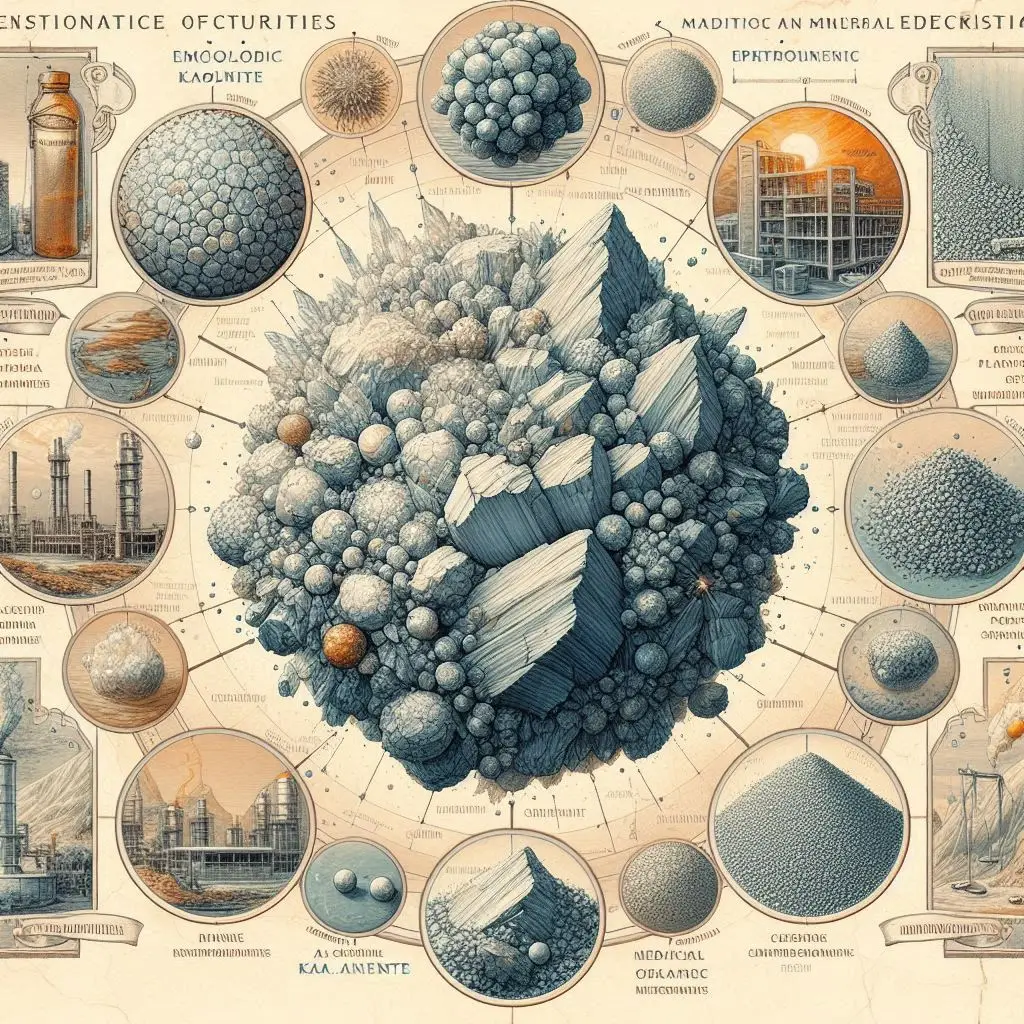
Kaolinite geological properties
In this discussion, I will explain the geological properties of kaolinite, its emergence, dispersion, and significance in industrial and natural environments.
The mineral kaolinite is a clay that is important to many different geological formations and processes. Because of its special qualities, it is a useful resource for a variety of sectors, including medicines and ceramics.
The versatile and substantial clay mineral kaolinite has profound geological and industrial ramifications. Its distribution in sedimentary strata, interaction with different mineral deposits, and weathering processes all contribute to its geological significance. However, because of its distinct mineralogical and physical characteristics, it is a useful resource for a variety of industrial uses, including the manufacture of rubber, paper, ceramics, and medicines. Geological research and the sustainable use of kaolinite in a variety of sectors depend on an understanding of the mineral's geological characteristics.
Formation and Occurrence: Rocks rich in feldspar, including granite and gneiss, whether to produce kaolinite. Minerals such as feldspar are broken down into secondary minerals like quartz and kaolinite. Temperature, moisture content, and the presence of organic acids are some of the variables that influence this weathering process. A critical stage in the creation of kaolin deposits is the conversion of feldspar into kaolinite.
Kaolinite is often found in sedimentary rocks, where weathered material deposition and transit cause it to accumulate. The material is often found in combination with other clay minerals such as illite and halloysite. Major kaolin deposits may be found in places like the United States, Brazil, China, and the United Kingdom. However, kaolin deposits can vary widely in size and quality.
Mineralogy and Structure: Kaolinite is a member of the kaolin group and is classified as a phyllosilicate mineral. Al2Si2O5(OH)4 is its chemical formula, which indicates that aluminum (Al), silicon (Si), oxygen (O), and hydrogen (H) make up its makeup. Oxygen atoms hold the alternating layers of silica tetrahedra and alumina octahedra that make up the crystal structure of kaolinite. The distinctive "booklet" or platy structure of kaolinite is a result of the layers' loose binding, which allows water molecules to intercalate between them.
The mineral is frequently white or light, with a soft, earthy texture. Due to its physical characteristics, which include its high plasticity and little shrinkage after fire, it may be used in a variety of industrial settings.
Geological Significance: The main ingredient in kaolin, a kind of clay used to make pottery, paper, rubber, and other items, is kaolinite, which has significant geological implications. Its presence in sedimentary strata affects the fertility and characteristics of the soil. Furthermore, kaolinite has been discovered in correlation with certain mineral occurrences, offering a valuable understanding of the geological mechanisms that gave rise to their creation.
Industrial Uses:
Ceramics: Kaolinite is an essential component that gives the finished product desired qualities including strength, flexibility, and whiteness. It is used in the production of tiles, porcelain, and other ceramic products.
Paper business: To enhance the surface qualities of paper, kaolin clay is widely utilized as a coating material in the paper business. Enhanced brightness, opacity, and printability are attributed to its platy structure and small particle size.
Pharmaceuticals: Kaolinite's adsorption qualities are used by the pharmaceutical sector. Kaolin is used as an excipient in pharmaceutical formulations to improve smoothness and stability.
Rubber and Plastics: Kaolinite is used in rubber and plastic goods as a reinforcing filler to increase their mechanical strength and resistance to wear.
Ecological Effects and Sustainable Methods:
Although kaolinite has many industrial uses, the mining and processing of the material may hurt the environment. Mining operations related to kaolin mining may cause soil erosion, habitat disturbance, and changes to the area hydrology. Sustainable measures, however, may be put in place to reduce these effects. Methods including sustainable mining, reclaimed land, and water management may help extract kaolin sustainably while protecting biodiversity and ecosystems.
Green technology and environmentally friendly alternatives have gained more attention in recent years. Because of its natural availability and adaptability, kaolin is a desirable alternative for enterprises that care about the environment. Its promise to help create a more sustainable future is shown by its application in goods including sustainable agricultural methods, eco-friendly packaging, and biodegradable plastics.
study and Technological Developments: The whole potential of kaolinite is still being uncovered via ongoing study. Developments in analytical methods like scanning electron microscopy and X-ray diffraction allow for a more thorough comprehension of its crystal structure and characteristics. This information is essential for creating cutting-edge apps and streamlining industrial operations.
Furthermore, there are now more uses for kaolin because of nanotechnology. The special qualities of nano-sized kaolinite particles make them useful for environmental cleanup, catalysis, and medical applications. With additional study, kaolin's industrial importance might be increasingly diversified and its involvement in new technologies could grow.
Economic Impact Worldwide:
The economies of the producing nations are significantly impacted by the worldwide kaolin market. Processing and exporting kaolin helps the economy grow and creates jobs. The mineral is a valuable commodity on the global market because of its extensive usage in many different sectors, which guarantees a steady demand.

